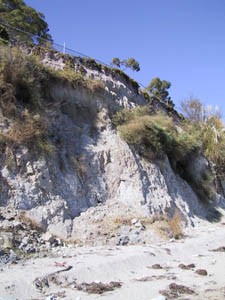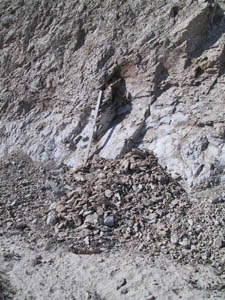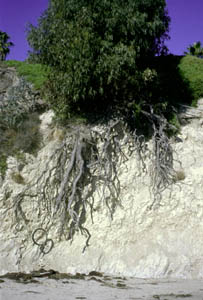|
UCSB Beach Cliff Erosion - Rock falls
and mass wasting
Rain, water, ground squirrels, surfers, weathering all contribute
to the breakdown of the siltstone and sandstone bedrock that constitutes
the UCSB beach cliff.
Fragments of the cliff continually break off and accumulate at the
bottom of the cliff as talus; cone shaped accumulations are called
talus cones. The cones grow larger and larger over time, until attacked
and washed away by ocean waves. This page and subsequent pages shows
examples of some talus cones and then how they were washed away by
large storm waves that drove into the cliffs during the week of January
8-12, 2001. |
|
|
|
| Pile of loose sand and shale rock at base of UCSB beach cliff. It
fell from the brown area in shadow so recently that some of the vegetation
in the pile is still green. 16 Nov 2000. ©AGS2000. |
Pile of shale rock at base of UCSB beach cliff. The rocks fell from
the recessed area partly in shadow right of the stick which is 5 feet
long. These rocks were completely washed during the storms and high
tides of 8-12 January 2001. 16 Nov 2000. ©AGS2000. |
|
|
|
| Tree roots dangling over cliff were bared by erosion of cliff rock.
Bicycle wheel gives scale. 4 Jan 2001. ©AGS2001 |
Every time surfers climb the hill, they cause a little dirt to go
down hill, but that dirt will never go back up hill. 9 Jan 2001. ©AGS2001 |
Back to Main Page |
NEXT PAGE |
Bluff Top Erosion |
|


